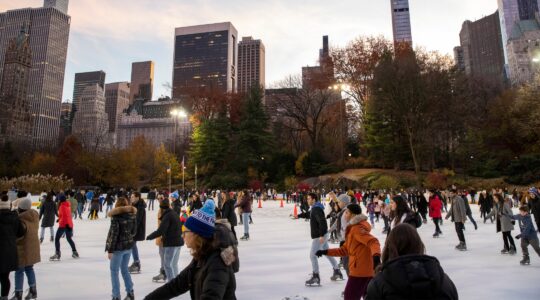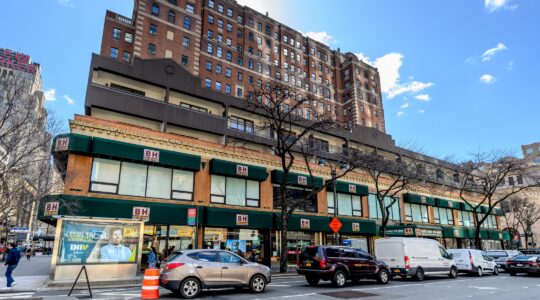On a stormy evening earlier this month, as Hurricane Florence barreled toward the Carolinas, the Dr. Bernard Heller Museum opened a timely show of art related to, or in response to, climate change and global warming and their devastating consequences.
“TERRA inFIRMA” includes the work of more than 60 artists working in many media, showing the fierce beauty of the natural world and what’s at stake.
The opening at Hebrew Union College-Jewish Institute of Religion/New York was accompanied by two significant events: the dedication of the museum in memory of Dr. Heller, a 1920 graduate of HUC in Cincinnati who was a pulpit rabbi in the U.S. and India, communal leader, faculty member of HUC in New York, author and successful businessman; and the granting of an honorary doctorate in humane letters to the museum’s longtime curator, Laura Kruger.
Over 25 years, Kruger, 82, has mounted more than 120 exhibitions at the New York campus that are based on contemporary interpretation of Jewish texts and traditions, published many catalogs, organized 20 traveling exhibitions and built an art collection at HUC with more than 2,500 works spanning the 20th and 21st centuries, with changing displays throughout the building. She has also created a community of Jewish artists who have shown their work together.
“It is because of Laura that the visual interpretation of Judaism is thriving here at the College-Institute,” Rabbi David Ellenson, interim president of HUC, said. He praised her as a visionary with “connoisseurship, imagination, expertise and devotion” whose many exhibitions “demonstrate how our values and history can be renewed by the visual arts.”
In an essay in the “TERRA inFIRMA” catalogue, Rabbi David Adelson, dean of HUC-JR/NY, writes of “a new commandment reverberating through all life. We must act to preserve the world.”
In her essay for the catalogue, Kruger explains that some of the topics covered in the show include the melting of ice caps, rising sea levels and floods, spontaneous fires, decimation of insect populations like bees and refugees forced to flee their homes because of disasters.
“We are not naïve enough to believe that art can correct any of these pending disasters. However, the language of art has a powerful visual and educational impact and can play a role in the urgently needed movement to correct human habits,” she writes.
The works on display are both realistic and abstract, and include photographs, tapestry, cartoons, collages and paintings. Collectively, they sound an alarm to save the planet. Moses Pini Siluk’s 2018 color photograph shows a fragile seedling in the Israeli desert, nurtured by drip irrigation. Another photograph, Dorit Jordan Dotan’s 2015 “A Micro-Cosmos,” is taken on the coastline of Haifa, with the sea coughing up trash caught in a tire tube close to shore. Water is a recurring theme; Rochelle Rubinstein’s banner inscribed with the words “water for life, not profit” depicts a water tower and truck above layers of water, rocks, animals and sea life.
Harriete Estel Berman’s “A Yard of Grass,” made of colorful tin cans, depicts intertwining blades of grass while Nathan Hilu’s “Banana Plant” suggests the inspiration of the natural world. Hilu, a 93-year-old New York artist, made his striking pastel, crayon and ink drawing based on trips to the Brooklyn Botanical Garden. Tobi Kahn’s “Noapha,” a dreamscape in sumptuous blue, evokes ice and glaciers, or the sea.
In his signature style, Hanan Harchol underlines the notion of responsibility toward future generations. In “Daddy Plants a Carob Tree,” he draws himself and his father, with a retelling of a Talmudic story below the drawing.
Ann Shapiro’s print “Puerto Rico: We Don’t Know What to Hope For” portrays the devastation to the beautiful natural landscape of the island in the wake of Hurricane Maria, which hit the island last year. Other works include Alex Hallatt’s cartoon “Arctic Circle”; Jeffrey Brosk’s wall sculpture “Journey” made of eucalyptus wood charred in an Australian forest fire; Yorgos Giotsas’s “Forest Floor,” which evokes an ancient scene; Deborah Ugoretz’s fold-out panel of strong images, “Six Days of Creation”; and Deborah Kruger’s “Harbinger,” with imagery of endangered birds and strips of text in endangered languages.
“Nature is giving us the clearest of warnings. We must act on its behalf, and ours, before it is too late,” Adriane Leveen, a professor of Bible at HUC, writes in a catalogue essay.
A woman of deep enthusiasm and high energy, Kruger wants people to look deeply at these pieces. Although she keeps turning the conversation toward the art, she also looks back on her career, which has been long, varied and distinguished.
“It all came to fruition here,” she tells The Jewish Week, referring to HUC.
Kruger’s first involvement in the arts was as a ballet dancer. She grew up in Forest Hills, Queens; her mother was a commercial artist and her father owned a fuel oil distribution company. At age 6 she began dancing and danced professionally throughout her teens, from 1948 to 1956 with the Ballet Russe de Monte Carlo, New York City Opera and Radio City Music Hall. After graduating from Hunter College and marrying Lewis Kruger, she left the ballet world and worked as a model for a bridal company. There, she discovered the “power of selling” and the fact that she loved talking to customers.
It was a natural shift to retail, and Kruger became a successful buyer of children’s clothing for the Arnold Constable department store chain, and then moved to Bloomingdale’s. Then, for 18 years, she owned a gallery on Madison Avenue selling one-of-a-kind jewelry. In 1978 someone came into the shop to see if she’d like to sell a handmade menorah, and she put it into her window. This was the beginning of her efforts in discovering and selling contemporary Judaica, and the beginning of her work in the Jewish world. Through her family’s rabbi in Sag Harbor, where her parents lived, she came to work at HUC.
Kruger says that she has been looking at and collecting art all of her life, and her retail background had given her a good sense of display, which she put to use expanding the art collection and curating shows. She still loves to talk about art.
In these 25 years, she sees that Jewish art has become more self-assured. “What passes for Jewish art in a lot of places is something with a Magen David [star of David] or menorah. I’m not talking about that. I’m interested in someone who connects with his or her faith, who reads, studies, who feels comfortable stating something.”
“I want to show Jewish talent at its best,” she adds, explaining that a lot of the artists she has shown in this exhibition and others address issues “not necessarily in an overt Jewish way but in a deeply regarded Jewish way.
“Can I define a Jewish aesthetic? No, because I don’t want to. I don’t think there’s a Jewish style of painting. I think there is an ethos in choosing a subject and perhaps an implied message from the subject that’s intuitive to the artist.”
“Laura is a truly sincere patron of the arts,” artist Tobi Kahn tells The Jewish Week. “I love her love of what art can be, which is an important attribute for a curator. She cares deeply, and works tirelessly to promote Jewish art and living Jewish artists.”
Hanan Harchol adds, “Laura Kruger is a force of nature and a visionary in the Jewish art world — I cannot think of anybody who has done more to bring awareness to contemporary artists who make art that speaks to the Jewish experience.”
“TERRA inFIRMA” runs through June 28 at the newly inaugurated Dr. Bernard Heller Museum at Hebrew Union College-Jewish Institute of Religion, 1 W. Fourth St., huc.edu.
The New York Jewish Week brings you the stories behind the headlines, keeping you connected to Jewish life in New York. Help sustain the reporting you trust by donating today.




